The Contribution of Forerunner to Storm Surges along the Vietnam Coast
Abstract
1. Introduction
2. Study Region
2.1. Bathymetry
2.2. Storm Characteristics
2.3. Tidal Regime
3. Methodology
3.1. Data
3.2. Data Analysis
3.2.1. Tidal Harmonic and Fourier Analysis
3.2.2. Low-Pass Filtering
3.2.3. Influence of Local Features and Storm Parameters
4. Results
4.1. Sea Level Time Series
4.2. Forerunner
4.2.1. Forerunner Generated by Alongshore Wind
4.2.2. Forerunner in Combination with Onshore Wind
4.2.3. Frequency of Forerunner and the Combination Surge
5. Discussion
5.1. Seasonal Sea Level Variation
5.2. Role of Forerunner
5.3. Influence of Local Features and Storm Characteristics
5.4. Implications
6. Conclusions
- The forerunner contributed significantly to the increase of the mean sea level prior to landfall, with the largest magnitude being 50 cm and 74 cm; the latter being in combination with onshore wind. Almost all typhoons generated a forerunner at least at one station with the forerunner contributing up to 50% of the total storm surge. Stations on the right of the typhoon track were often observed to contain a forerunner combining with onshore wind due to the typhoon winds rotating anti-clockwise around the low pressure under the Coriolis Effect.
- Similar typhoon paths often lead to similar signals of forerunners at certain stations. The size of the typhoon was more important than its intensity in the generation of the forerunner.
- Seasonal variability in the mean level was such that storms occurring later in the year coincided with higher mean sea levels due to the monsoon and spring tides, and thus, potentially have a higher maximum total water level.
Author Contributions
Funding
Acknowledgments
Conflicts of Interest
References
- Lin, N.; Emanuel, K.; Oppenheimer, M.; Vanmarcke, E. Physically based assessment of hurricane surge threat under climate change. Nat. Clim. Chang. 2012, 2, 462–467. [Google Scholar] [CrossRef]
- Haigh, I.D.; MacPherson, L.R.; Mason, M.; Wijeratne, E.M.S.; Pattiaratchi, C.; Crompton, R.P.; George, S. Estimating present day extreme water level exceedance probabilities around the coastline of Australia: Tropical cyclone-induced storm surges. Clim. Dyn. 2013, 42, 139–157. [Google Scholar] [CrossRef]
- Vecchi, G.A.; Soden, B.J. Effect of remote sea surface temperature change on tropical cyclone potential intensity. Nature 2007, 450, 1066–1070. [Google Scholar] [CrossRef] [PubMed]
- Le, T.A.; Takagi, H.; Heidarzadeh, M.; Takata, Y.; Takahashi, A. Field Surveys and Numerical Simulation of the 2018 Typhoon Jebi: Impact of High Waves and Storm Surge in Semi-enclosed Osaka Bay, Japan. Pure Appl. Geophys. 2019, 176, 4139–4160. [Google Scholar] [CrossRef]
- Heidarzadeh, M.; Teeuw, R.; Day, S.; Solana, C. Storm wave run ups and sea level variations for the September 2017 Hurricane Maria along the coast of Dominica, eastern Caribbean Sea: Evidence from field surveys and sea level data analysis. Coast. Eng. J. 2018, 60, 371–384. [Google Scholar] [CrossRef]
- Eliot, M.; Pattiaratchi, C. Remote forcing of water levels by tropical cyclones in southwest Australia. Cont. Shelf Res. 2010, 30, 1549–1561. [Google Scholar] [CrossRef]
- Thai, T.H.; Thuy, N.B.; Dang, V.H.; Kim, S.; Hole, L.R. Impact of the interaction of surge, wave and tide on a storm surge on the north coast of Vietnam. Procedia IUTAM 2017, 25, 82–91. [Google Scholar] [CrossRef]
- Dasallas, L.; Lee, S. Topographical Analysis of the 2013 Typhoon Haiyan Storm Surge Flooding by Combining the JMA Storm Surge Model and the FLO-2D Flood Inundation Model. Water 2019, 11, 144. [Google Scholar] [CrossRef]
- Kennedy, A.; Gravois, U.; Zachry, B.C.; Westerink, J.J.; Hope, M.E.; Dietrich, J.C.; Powell, M.; Cox, A.T.; Luettich, R.A.; Dean, R.G. Origin of the Hurricane Ike forerunner surge. Geophys. Res. Lett. 2011, 38. [Google Scholar] [CrossRef]
- Thuy, N.B.; Cuong, H.D.; Tien, D.D.; Chien, D.D.; Kim, S.Y. Assessment of changes in sea level caused by Typhoon No. 3 (Kalmaegi) in 2014 and forecast problems. Sci. Tech. Meteorol. J. 2014, 647, 16–20. (In Vietnamese) [Google Scholar]
- Liu, Y.; Irish, J.L. Characterization and prediction of tropical cyclone forerunner surge. Coast. Eng. 2019, 147, 34–42. [Google Scholar] [CrossRef]
- Suh, S.-W.; Lee, H.-Y. Forerunner storm surge under macro-tidal environmental conditions in shallow coastal zones of the Yellow Sea. Cont. Shelf Res. 2018, 169, 1–16. [Google Scholar] [CrossRef]
- Pugh, D.T. Tides, Surges and Mean Sea Level—A Handbook for Engineers and Scientists; John Wiley & Sons: Chichester, UK, 1987; p. 472. [Google Scholar]
- Janowitz, G.S.; Pietrafesa, L.J. Subtidal frequency fluctuations in coastal sea level in the mid and south Atlantic Bights: A prognostic for coastal flooding. J. Coast. Res. 1996, 12, 79–89. [Google Scholar]
- Thuy, N.B.; Kim, S.; Chien, D.D.; Dang, V.H.; Cuong, H.D.; Wettre, C.; Hole, L.R. Assessment of Storm Surge along the Coast of Central Vietnam. J. Coast. Res. 2016, 33, 518–530. [Google Scholar] [CrossRef]
- Thuy, V.T.T. Storm Surge Modeling for Vietnam’s Coast. Master’s Thesis, IHE Delft: Delft, The Nederlands, 2003; p. 140. [Google Scholar]
- Express.co.uk. Vietnam Lashed by Typhoon Doksuri—Flooding, Loss of Power and Houses Destroyed. Available online: https://www.express.co.uk/news/world/854559/Vietnam-Typhoon-Doksuri-2017-path-weather-flood-evacuation (accessed on 16 March 2019).
- Takagi, H.; Thao, N.D.; Esteban, M. Tropical Cyclones and Storm Surges in Southern Vietnam. In Coastal Disasters and Climate Change in Vietnam; Thao, N.D., Takagi, H., Esteban, M., Eds.; Elsevier: Amsterdam, The Netherlands, 2014; pp. 3–16. [Google Scholar]
- Fang, G.; Kwok, Y.K.; Yu, K.; Zhu, Y. Numerical simulation of principal tidal constituents in the South China Sea, Gulf of Tonkin and Gulf of Thailand. Cont. Shelf Res. 1999, 19, 845–869. [Google Scholar] [CrossRef]
- Caldwell, P.; Merrifield, M.; Thompson, P. Sea level measured by tide gauges from global oceans as part of the Joint Archive for Sea Level (JASL) from 1846-01-01 to 2015-07-31. Natl. Oceanogr. Data Center 2015, 10, V5V40S7W. [Google Scholar]
- Pugh, D.; Woodworth, P. Sea-Level Science: Understanding Tides, Surges, Tsunamis and Mean Sea-Level Changes; Cambridge University Press: Cambridge, UK, 2014. [Google Scholar]
- Jin, G.; Pan, H.; Zhang, Q.; Lv, X.; Zhao, W.; Gao, Y. Determination of Harmonic Parameters with Temporal Variations: An Enhanced Harmonic Analysis Algorithm and Application to Internal Tidal Currents in the South China Sea. J. Atmos. Ocean. Technol. 2018, 35, 1375–1398. [Google Scholar] [CrossRef]
- Pawlowicz, R.; Beardsley, B.; Lentz, S. Classical tidal harmonic analysis including error estimates in MATLAB using T_TIDE. Comput. Geosci. 2002, 28, 929–937. [Google Scholar] [CrossRef]
- Moftakhari, H.R.; Jay, D.A.; Talke, S.A.; Kukulka, T.; Bromirski, P.D. A novel approach to flow estimation in tidal rivers. Water Resour. Res. 2013, 49, 4817–4832. [Google Scholar] [CrossRef]
- Consoli, S.; Recupero, D.R.; Zavarella, V. A survey on tidal analysis and forecasting methods for Tsunami detection. arXiv 2014, arXiv:1403.0135. [Google Scholar]
- Wijeratne, E.; Pattiaratchi, C.; Eliot, M.; Haigh, I.D. Tidal characteristics in Bass Strait, south-east Australia. Estuar. Coast. Shelf Sci. 2012, 114, 156–165. [Google Scholar] [CrossRef]
- Thompson, R.O.R.Y. Low-Pass Filters to Suppress Inertial and Tidal Frequencies. J. Phys. Oceanogr. 1983, 13, 1077–1083. [Google Scholar] [CrossRef]
- Sebastian, M.; Behera, M.R.; Murty, P. Storm surge hydrodynamics at a concave coast due to varying approach angles of cyclone. Ocean Eng. 2019, 191, 106437. [Google Scholar] [CrossRef]
- Pattiaratchi, C. Coastal tide gauge observations: Dynamic processes present in the Fremantle record. In Operational Oceanography in the 21st Century; Springer: Berlin/Heidelberg, Germany, 2011; pp. 185–202. [Google Scholar]
- Amiruddin, A.M.; Haigh, I.D.; Tsimplis, M.; Calafat, F.M.; Dangendorf, S. The seasonal cycle and variability of sea level in the South China Sea. J. Geophys. Res. Oceans 2015, 120, 5490–5513. [Google Scholar] [CrossRef]
- Ho, C.-R.; Zheng, Q.; Soong, Y.S.; Kuo, N.-J.; Hu, J. Seasonal variability of sea surface height in the South China Sea observed with TOPEX/Poseidon altimeter data. J. Geophys. Res. Space Phys. 2000, 105, 13981–13990. [Google Scholar] [CrossRef]
- Orton, P.M.; Talke, S.A.; Jay, D.A.; Yin, L.; Blumberg, A.F.; Georgas, N.; Zhao, H.; Roberts, H.J.; MacManus, K. Channel Shallowing as Mitigation of Coastal Flooding. J. Mar. Sci. Eng. 2015, 3, 654–673. [Google Scholar] [CrossRef]
- Atkinson, J.; Smith, J.M.; Bender, C. Sea-Level Rise Effects on Storm Surge and Nearshore Waves on the Texas Coast: Influence of Landscape and Storm Characteristics. J. Waterw. Port Coast. Ocean Eng. 2013, 139, 98–117. [Google Scholar] [CrossRef]


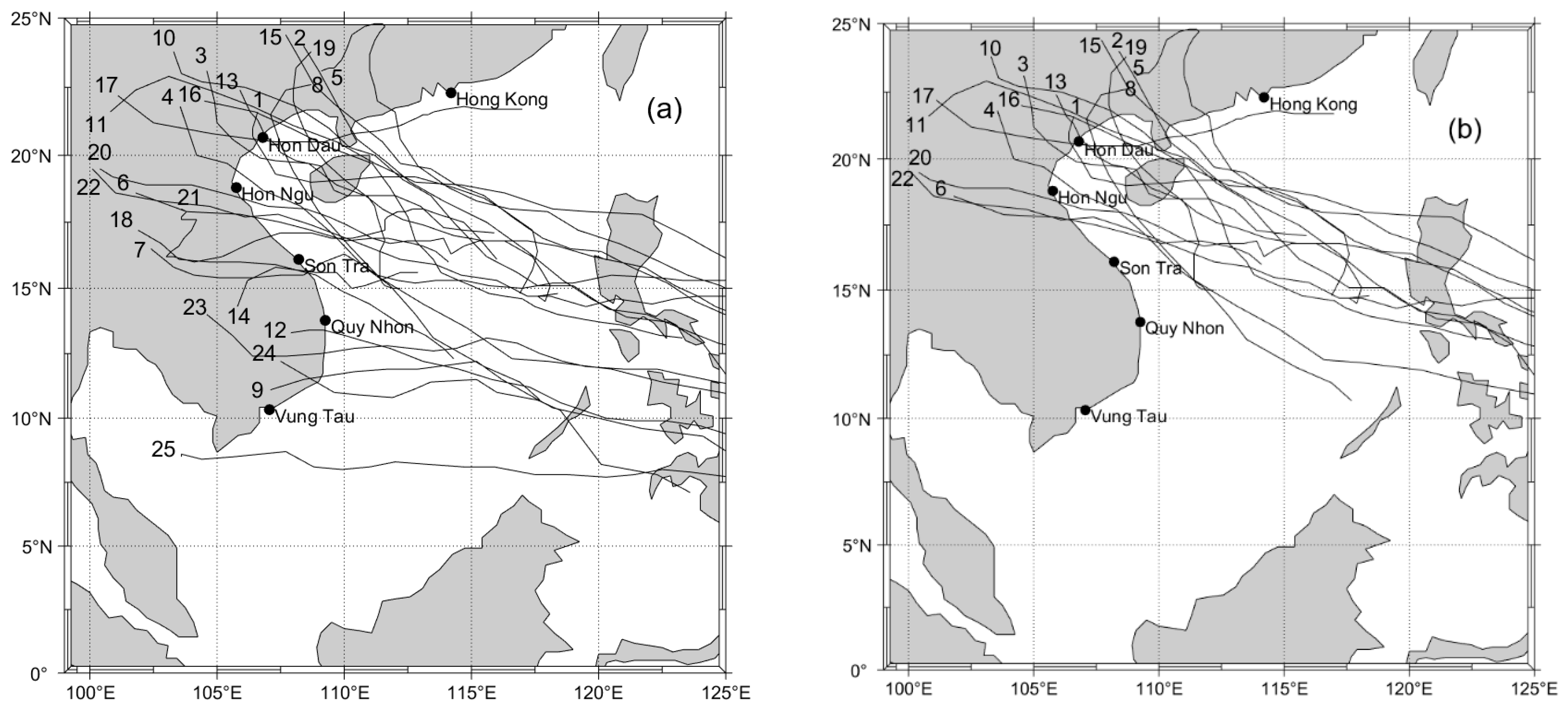
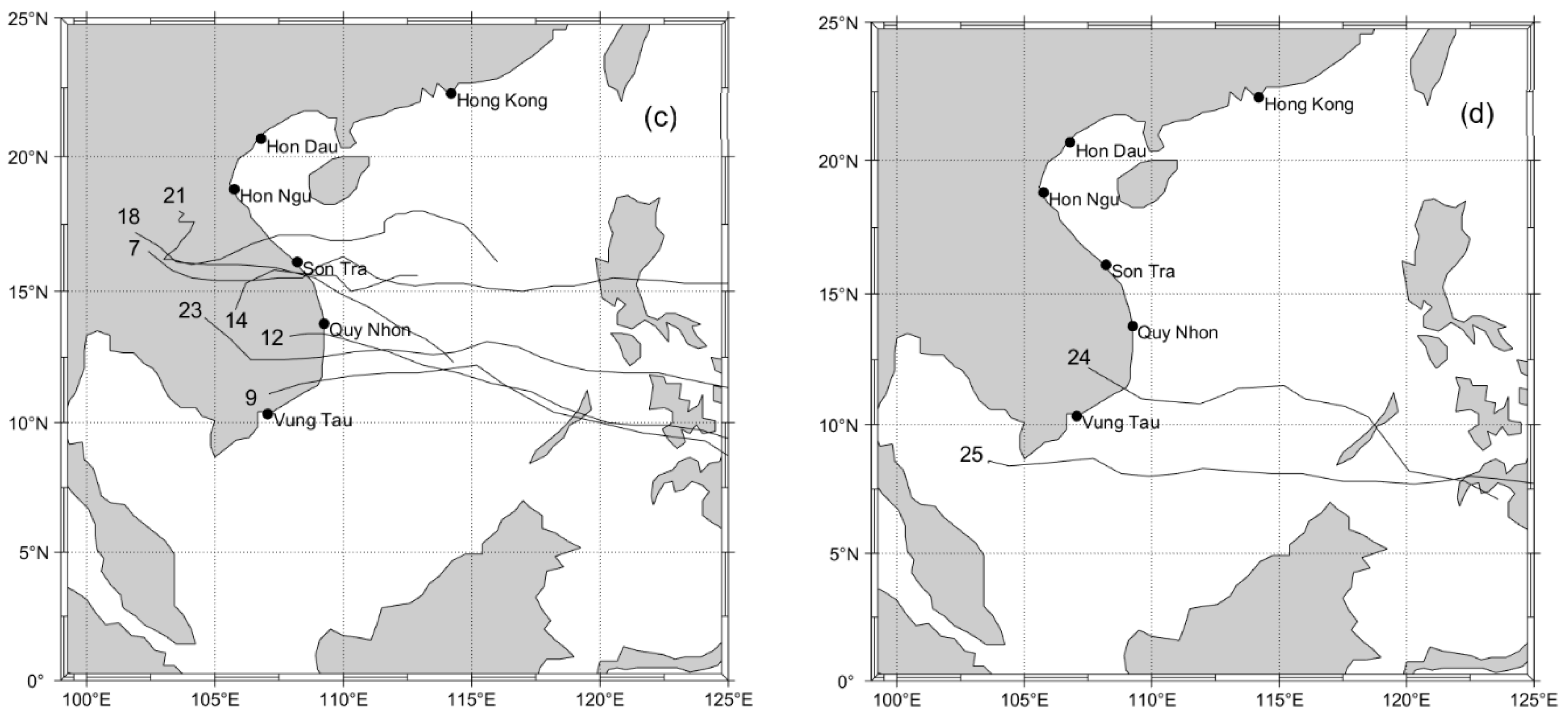
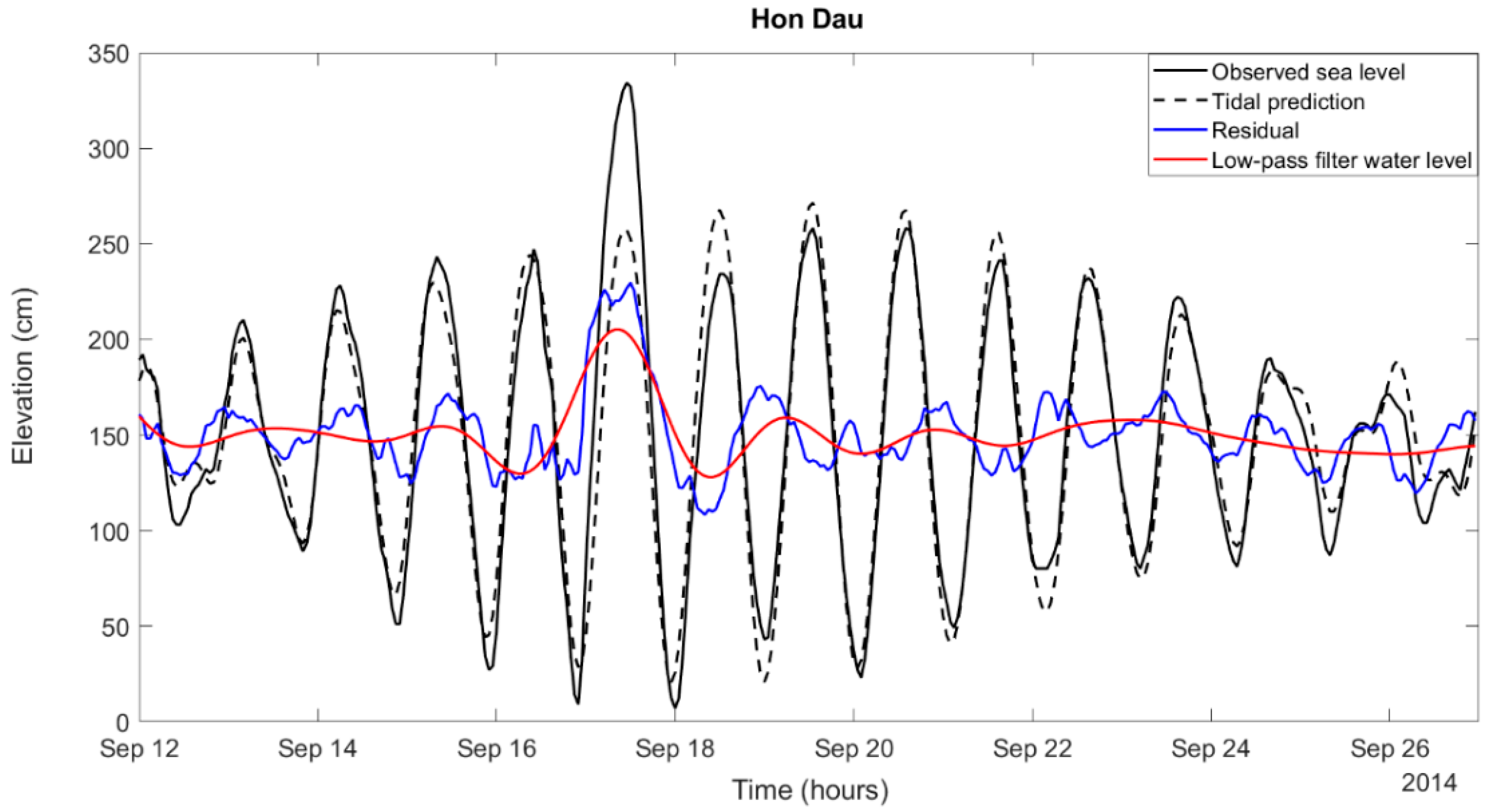
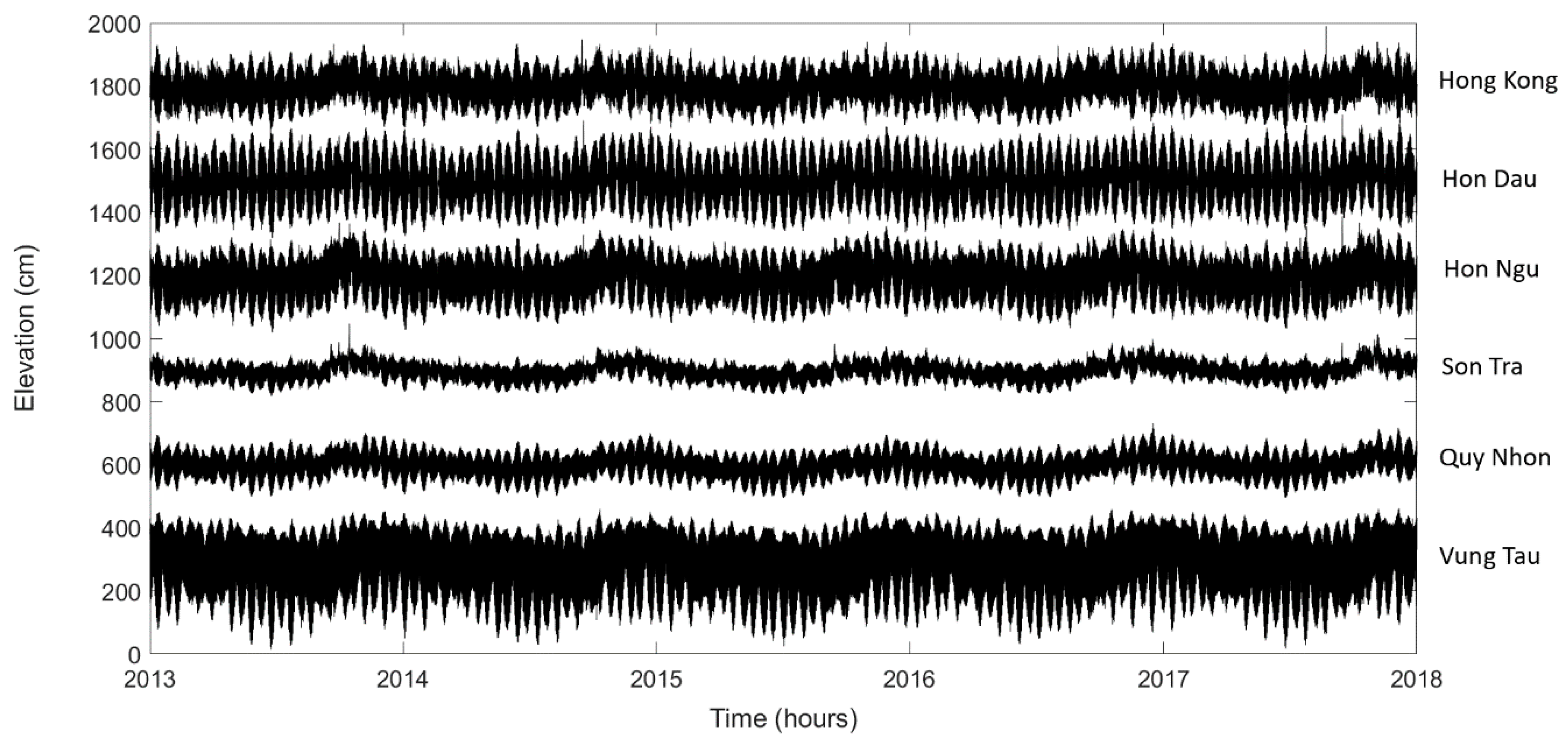
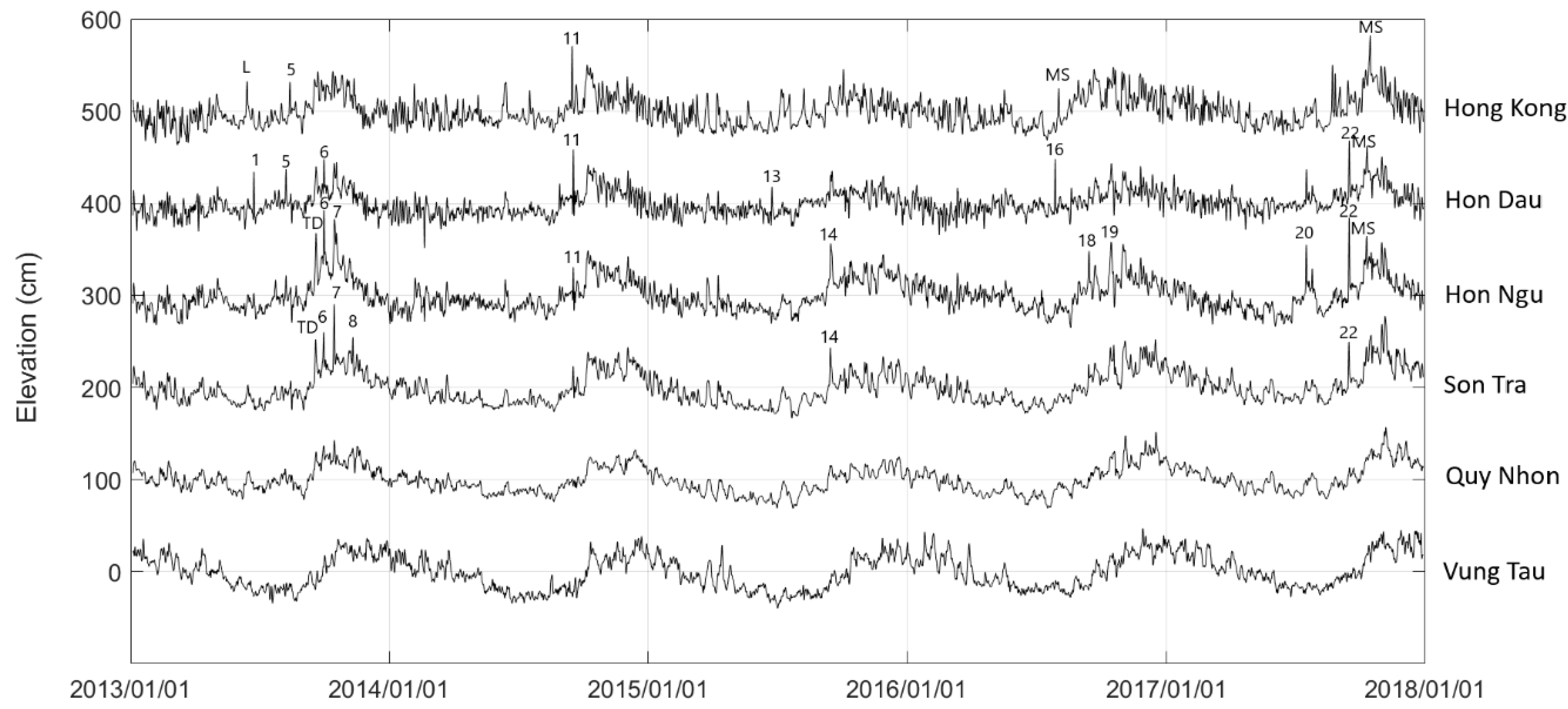
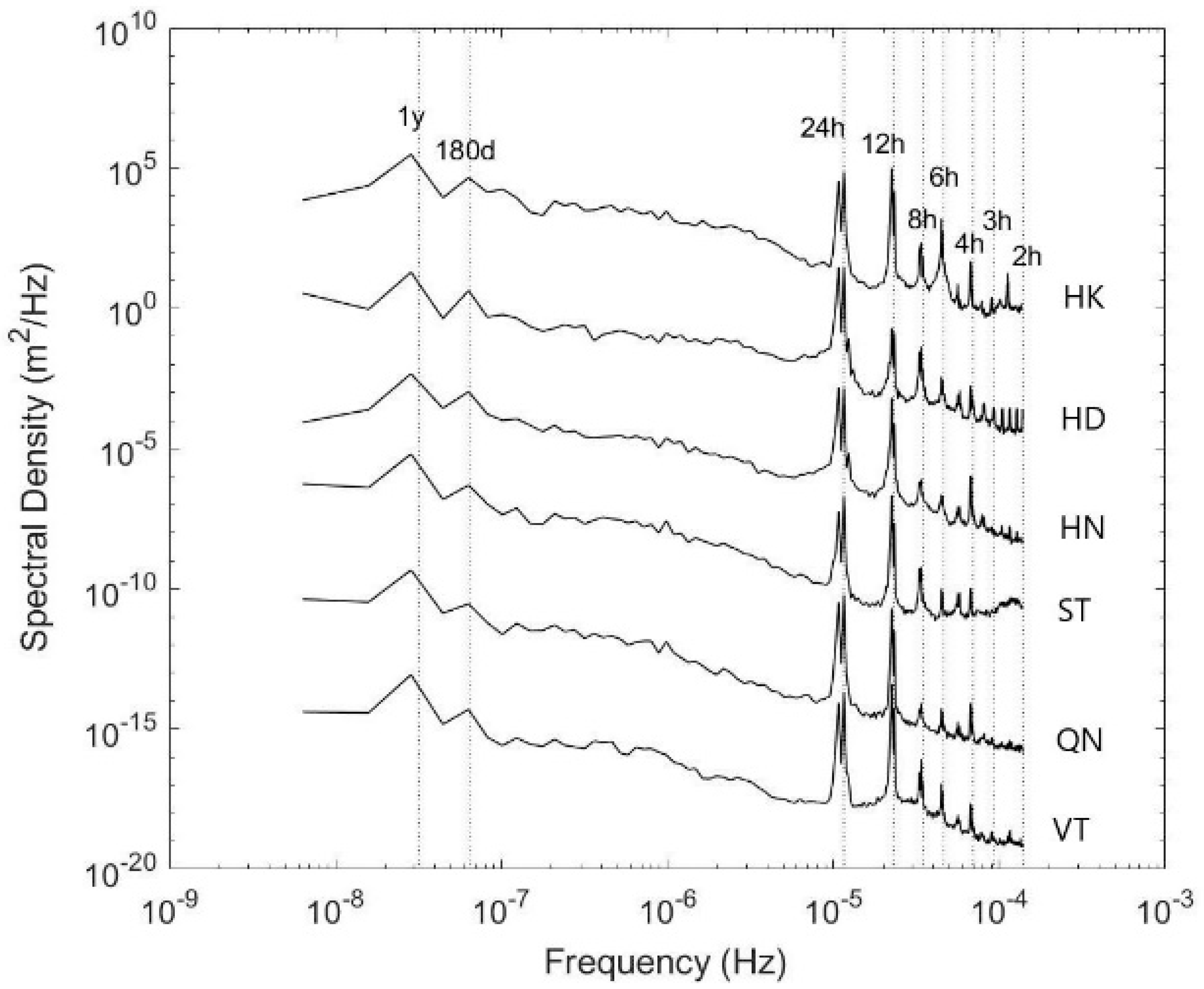

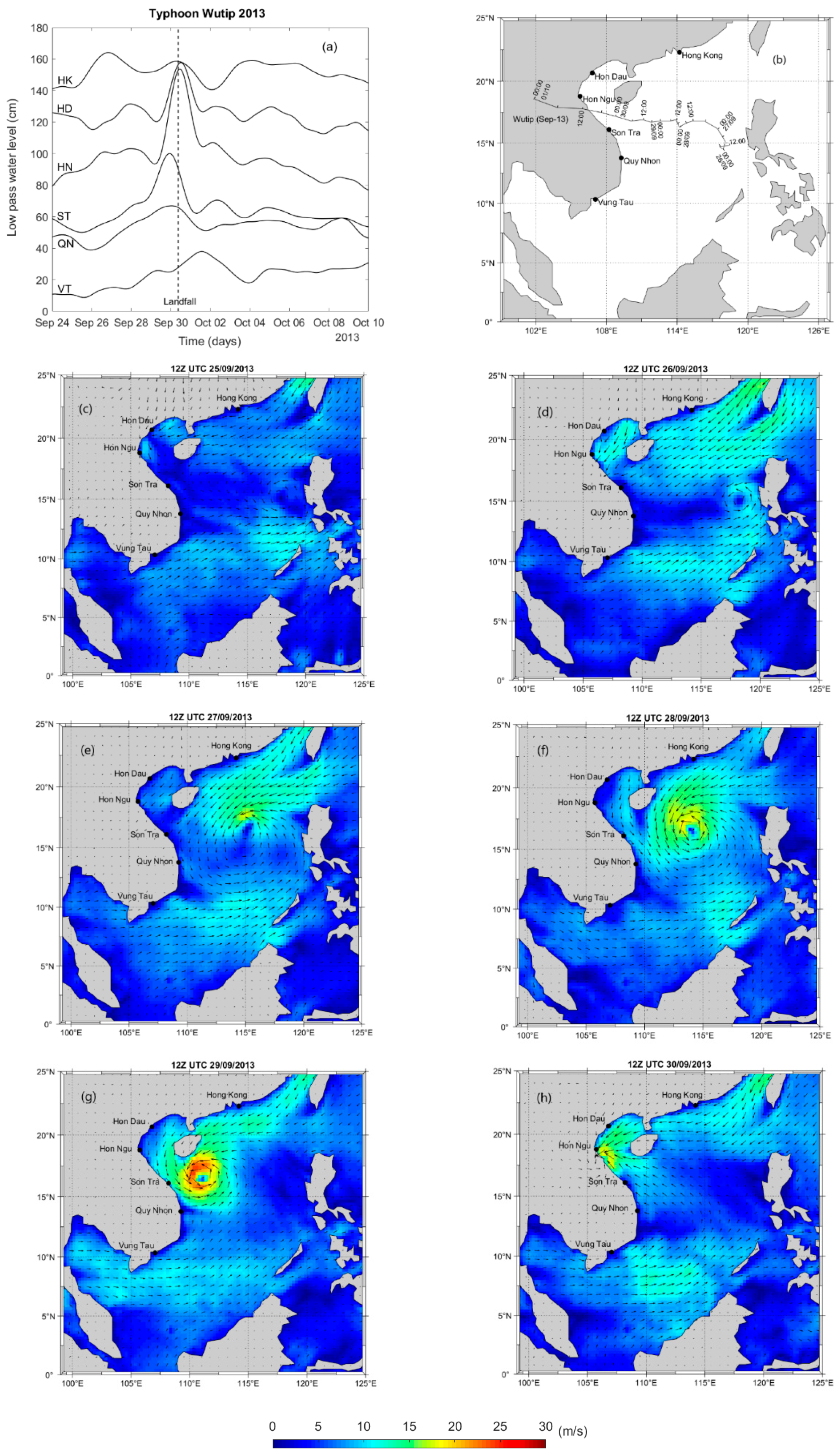
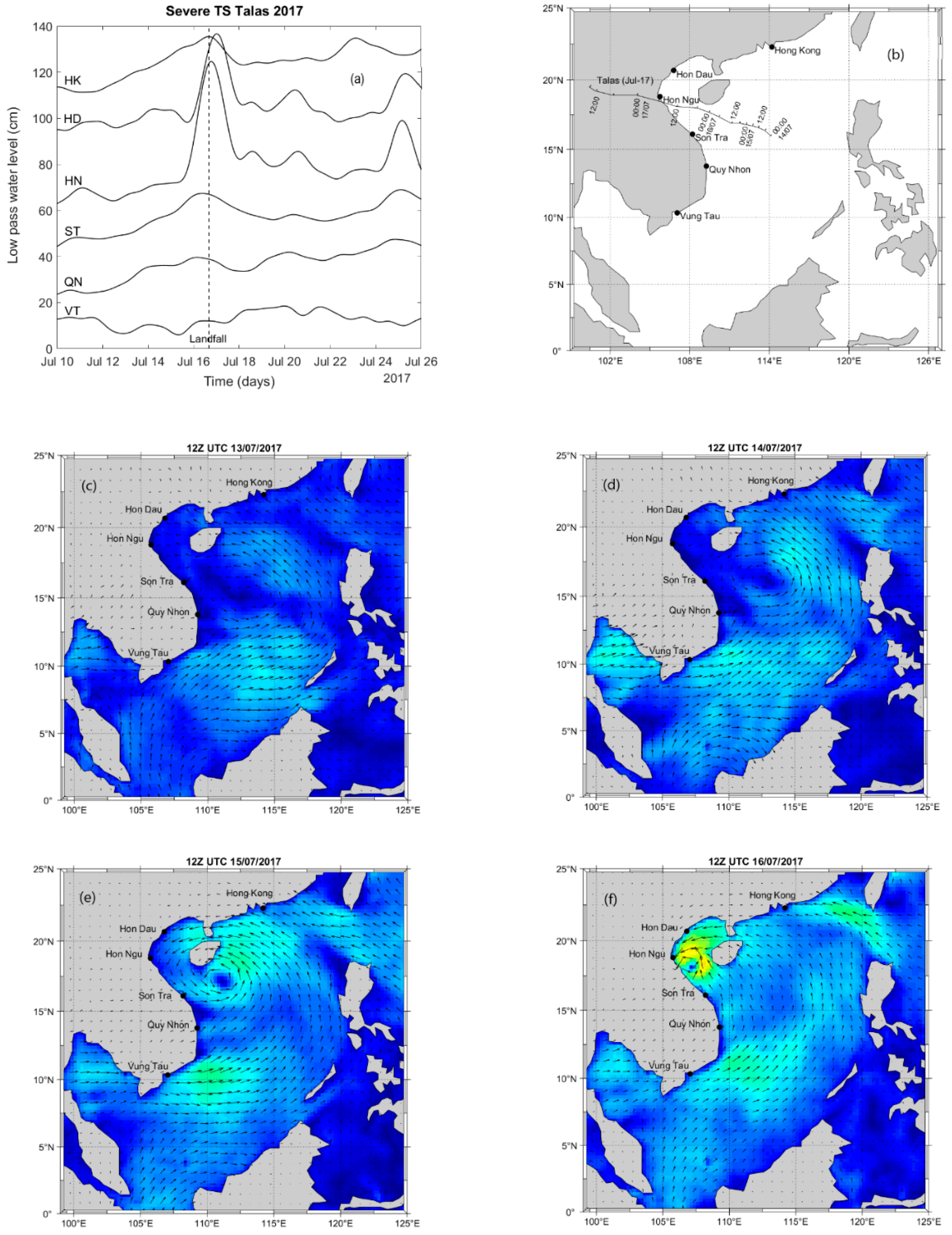

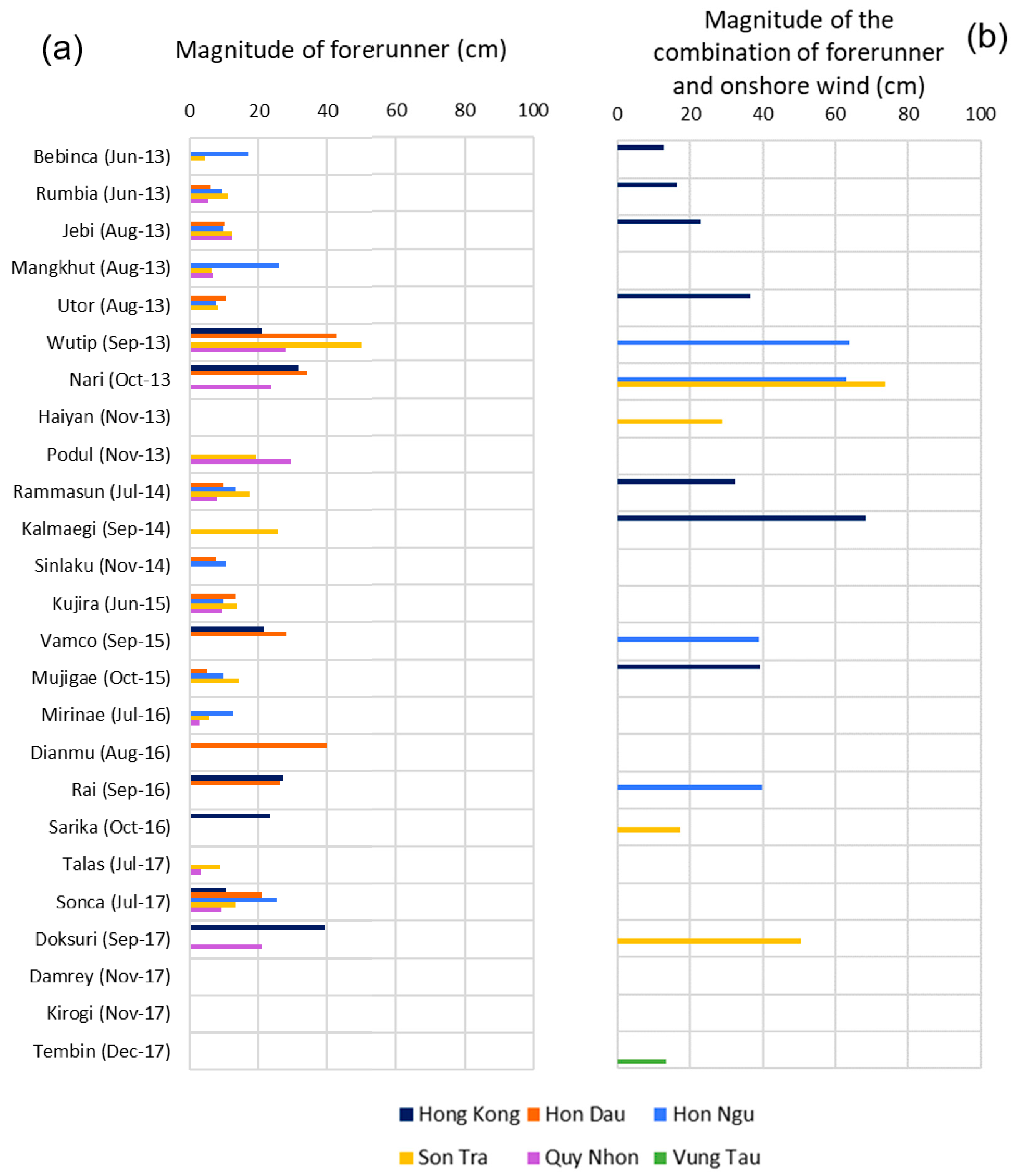
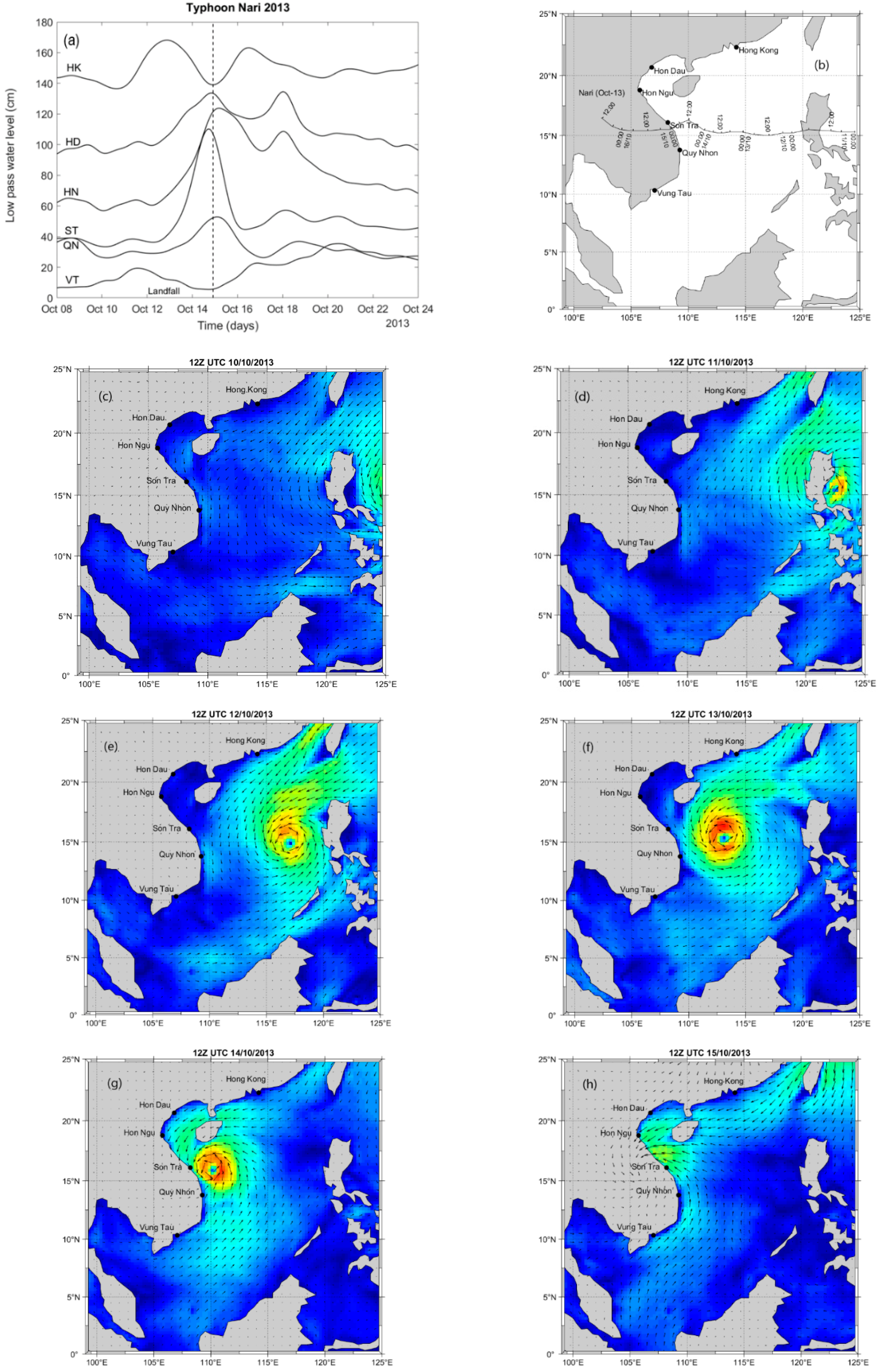
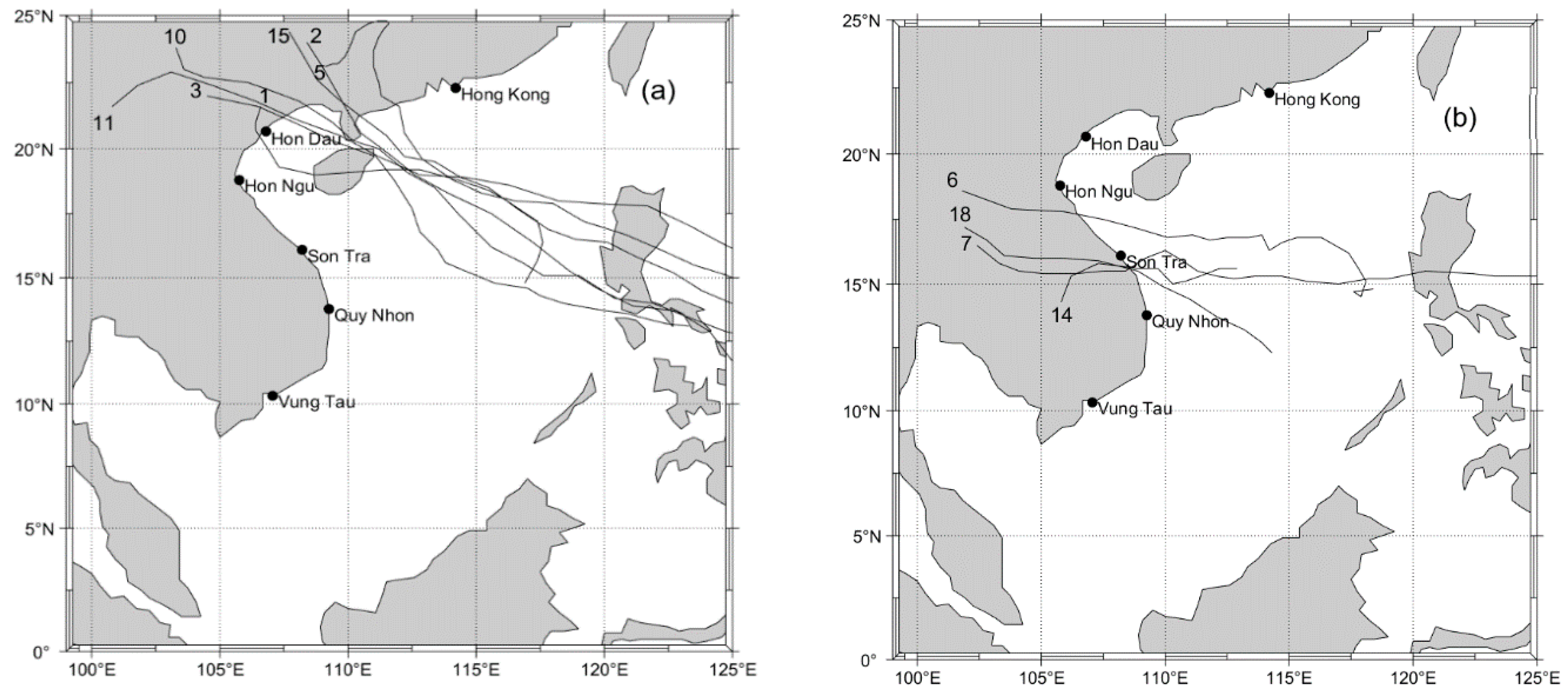
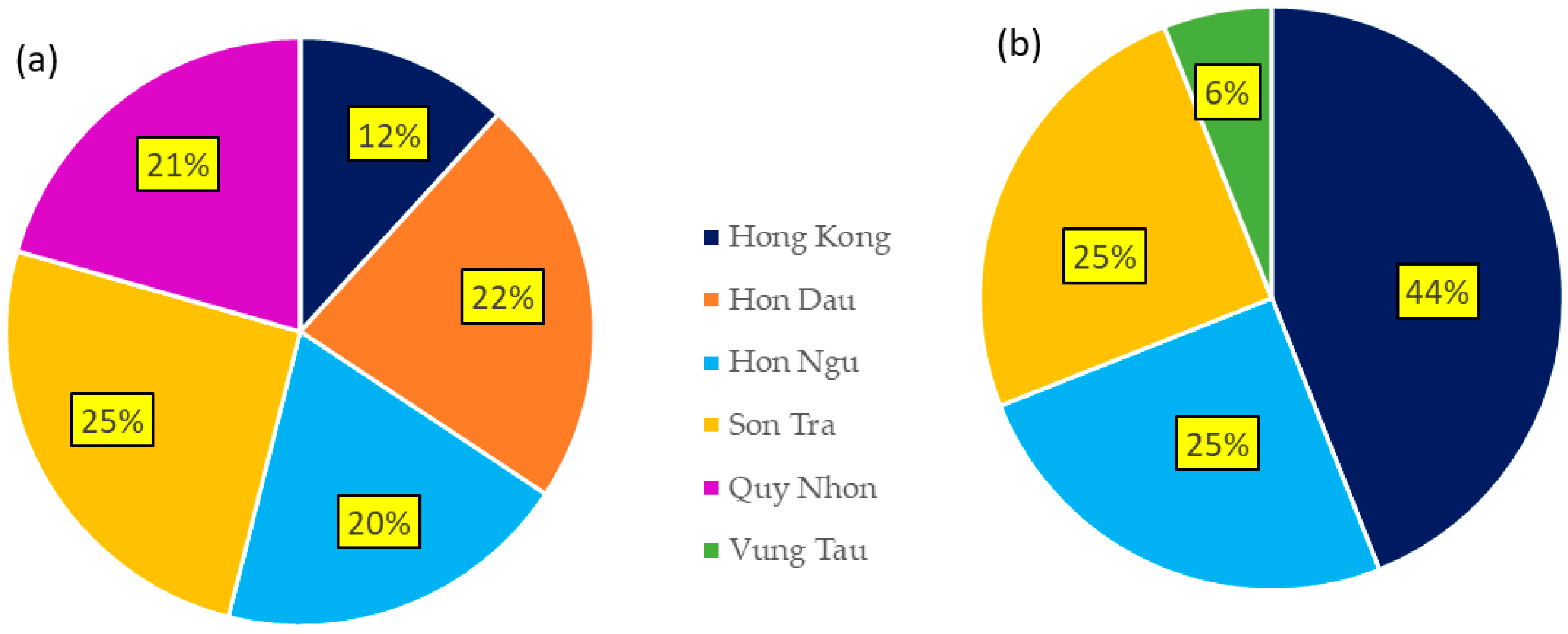

| Coastal Section | Location | Amplitude of Tidal Constituents | Tidal Character (Form Factor) | Mean Tidal Range (m) | |||
|---|---|---|---|---|---|---|---|
| M2 (cm) | S2 (cm) | K1 (cm) | O1 (cm) | ||||
| Chinese coast | Hong Kong | 38 | 15 | 36 | 29 | Mixed, semi-diurnal (1.2) | 2.0–2.5 |
| Northern Coast | Hon Dau Hon Ngu | 6 | 3 | 85 | 25 | Diurnal tides (12.2) Diurnal tides (4.1) | 3–4 1.2–2.5 |
| 30 | 9 | 103 | 58 | ||||
| Central Coast | Son Tra Quy Nhon | 17 | 6 | 20 | 13 | Mixed, semi-diurnal (1.4) Mixed diurnal regime (2.5) | 0.5 1.2–2.0 |
| 18 | 6 | 34 | 27 | ||||
| Southern Coast | Vung Tau | 79 | 30 | 61 | 46 | Mixed semi-diurnal (1.0) | 3–4 |
| Station Name * | Latitude | Longitude | Country |
|---|---|---|---|
| Hong Kong | 22.30 | 114.20 | Hong Kong |
| Hon Dau | 20.66 | 106.80 | Vietnam |
| Hon Ngu | 18.80 | 105.76 | Vietnam |
| Son Tra | 16.10 | 108.21 | Vietnam |
| Quy Nhon | 13.77 | 109.25 | Vietnam |
| Vung Tau | 10.34 | 107.07 | Vietnam |
© 2020 by the authors. Licensee MDPI, Basel, Switzerland. This article is an open access article distributed under the terms and conditions of the Creative Commons Attribution (CC BY) license (http://creativecommons.org/licenses/by/4.0/).
Share and Cite
Trinh, T.T.; Pattiaratchi, C.; Bui, T. The Contribution of Forerunner to Storm Surges along the Vietnam Coast. J. Mar. Sci. Eng. 2020, 8, 508. https://doi.org/10.3390/jmse8070508
Trinh TT, Pattiaratchi C, Bui T. The Contribution of Forerunner to Storm Surges along the Vietnam Coast. Journal of Marine Science and Engineering. 2020; 8(7):508. https://doi.org/10.3390/jmse8070508
Chicago/Turabian StyleTrinh, Tam Thi, Charitha Pattiaratchi, and Toan Bui. 2020. "The Contribution of Forerunner to Storm Surges along the Vietnam Coast" Journal of Marine Science and Engineering 8, no. 7: 508. https://doi.org/10.3390/jmse8070508
APA StyleTrinh, T. T., Pattiaratchi, C., & Bui, T. (2020). The Contribution of Forerunner to Storm Surges along the Vietnam Coast. Journal of Marine Science and Engineering, 8(7), 508. https://doi.org/10.3390/jmse8070508






